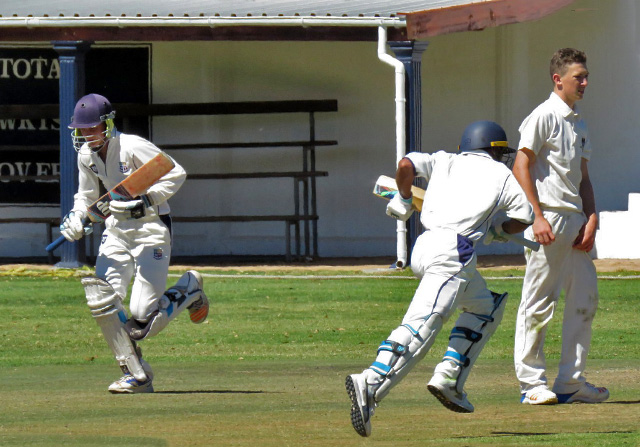Running speed, acceleration, and agility are very important physical attributes for cricket players, particularly for moving between the wickets and when fielding. The Run 2 Speed Test is a cricket fitness test that assesses both speed and agility in a very specific cricket situation (there is also a similar run-a-three cricket test). The Run 2 Test involves sprinting over the actual pitch distance twice, carrying a bat and incorporating one 180 degree turn. This test not only assesses cricket specific running speed, but also technique on the turn and the ability to run with the bat in hand.
 running between wickets in a cricket match
running between wickets in a cricket matchtest purpose: The aim of this test is to assess a player's ability to run quickly between the wickets within a match.
equipment required: timing gates or stopwatch, non-slip running surface (preferably a cricket pitch), tape for marking the ground and cone markers.
pre-test: Explain the test procedures to the subject. Perform screening of health risks and obtain informed consent. Prepare forms and record basic information such as age, height, body weight, gender, test conditions including the running surface. Measure and mark out the test area. Perform an appropriate warm-up. Set up and test the timing gates. See more details of pre-test procedures.

test setup: If the test is not performed on a cricket pitch, then lines marking the creases need to be made 58 feet or 17.68 meters apart. If using timing gates, they are set up at the line of the popping (batting) crease at each end. Set the timing gates low so that a sliding bat will activate the timer.
procedure: The run 2 test involves sprinting the length of the cricket pitch, turning and returning to the starting position. The players carry their cricket bat, but do not wear pads and helmet. The starting position is with the foot behind the starting line with the bat in hand. At the turn, players should reach out and slide the bat over the crease mark, then slide the bat ahead of them at the finish as they would in a match. The test should be performed with the bat in the dominant hand, and also the non-preferred hand (and therefore turning off each the left and right foot).
results: Record the total time to the nearest 0.01 seconds. Two trials are allowed with the bat in each hand, and the fastest times recorded. A group of international male English cricketers recorded an average time of 6.10 ± 0.16 seconds in 2020 (Ahmun et al. 2020). Results for professional (P) and non-professional (NP) female cricketers (Brazier et al. 2024) were: seam-bowlers 6.93 ± 0.20 (P) and 7.04 ± 0.19 (NP) seconds, and non seam-bowlers 6.79 ± 0.30 (P) and 7.01 ± 0.31 (NP) seconds. The results for the non-dominent hand was between 0.06 and 0.12 seconds slower on average.
target population: cricket players of all levels.
variations:
- You could also measure and compare to the running speed for run-a-three, and also a straight 17.68m quick single.
- Wearing pads and helmet can add to the cricket specificity of this test.
comments:
- The distance from stumps to stumps is 22 yards / 66 feet / 20.12m, with the popping crease at each end 4 feet (1.22m) from the stumps. Therefore, from crease to crease is 66 - (2 x 4) = 58 feet, or 17.68 meters.
- The run 2 test has at some stage been part of the English and Wales Cricket Board regional profiling assessment.
References:
- Ahmun R, Scott P, Jones TW and Tallent, J. Sprint acceleration mechanical profiling of international cricketers. International Journal of Sports Science & Coaching 2020; 15: 745-752.
- Brazier TA, Tallent J, Patterson SD, Howe LP, Callaghan SJ. The physical profile of female cricketers: An investigation between playing standard and position. PLoS One. 2024 Jun 10;19(6).
- Houghton, L. A. (2010). Running between the Wickets in Cricket: What is the Fastest Technique? International Journal of Sports Science & Coaching, 5(1), 101–107.
Similar Tests
- Run-a-Three — a cricket speed and agility test, involving sprinting over a cricket pitch distance three times while carrying a bat.
- 5-0-5 Agility Test — run 5m and back, testing 180 degree turning ability.
- Straight 17.68m Sprint — running speed test over the length of a standard cricket wicket.
Related Pages
- More about fitness testing for cricket
- General information about Sprint or Speed Testing
- Training for speed
- Warming up for sprint testing
- Other anaerobic tests and about anaerobic testing
- Fitness for Cricket
- We have listed some suggested tests for testing cricket players.
- Cricket Training Programs
- Fitness Components for Cricket
- Discussion about Who Is The Fittest Cricket Player Ever?


 Current Events
Current Events